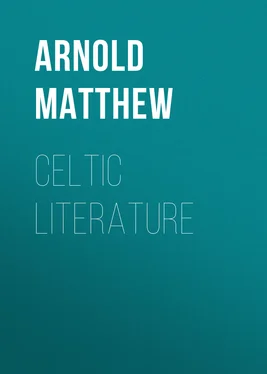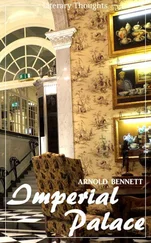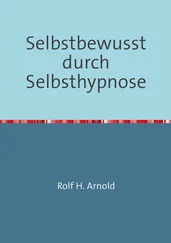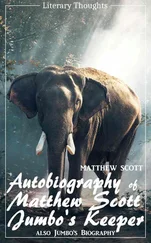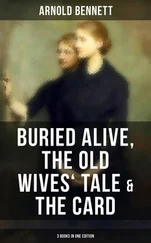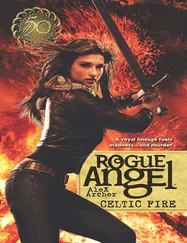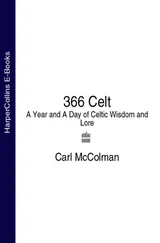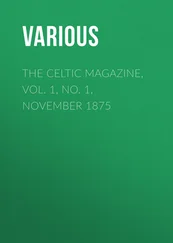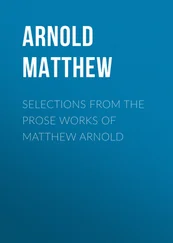Matthew Arnold - Celtic Literature
Здесь есть возможность читать онлайн «Matthew Arnold - Celtic Literature» — ознакомительный отрывок электронной книги совершенно бесплатно, а после прочтения отрывка купить полную версию. В некоторых случаях можно слушать аудио, скачать через торрент в формате fb2 и присутствует краткое содержание. Жанр: foreign_antique, Языкознание, literature_19, Культурология, на английском языке. Описание произведения, (предисловие) а так же отзывы посетителей доступны на портале библиотеки ЛибКат.
- Название:Celtic Literature
- Автор:
- Жанр:
- Год:неизвестен
- ISBN:нет данных
- Рейтинг книги:5 / 5. Голосов: 1
-
Избранное:Добавить в избранное
- Отзывы:
-
Ваша оценка:
- 100
- 1
- 2
- 3
- 4
- 5
Celtic Literature: краткое содержание, описание и аннотация
Предлагаем к чтению аннотацию, описание, краткое содержание или предисловие (зависит от того, что написал сам автор книги «Celtic Literature»). Если вы не нашли необходимую информацию о книге — напишите в комментариях, мы постараемся отыскать её.
Celtic Literature — читать онлайн ознакомительный отрывок
Ниже представлен текст книги, разбитый по страницам. Система сохранения места последней прочитанной страницы, позволяет с удобством читать онлайн бесплатно книгу «Celtic Literature», без необходимости каждый раз заново искать на чём Вы остановились. Поставьте закладку, и сможете в любой момент перейти на страницу, на которой закончили чтение.
Интервал:
Закладка:
In the sphere of politics, too, there has, in the same way, appeared an indirect practical result from this science; the sense of antipathy to the Irish people, of radical estrangement from them, has visibly abated amongst all the better part of us; the remorse for past ill-treatment of them, the wish to make amends, to do them justice, to fairly unite, if possible, in one people with them, has visibly increased; hardly a book on Ireland is now published, hardly a debate on Ireland now passes in Parliament, without this appearing. Fanciful as the notion may at first seem, I am inclined to think that the march of science,—science insisting that there is no such original chasm between the Celt and the Saxon as we once popularly imagined, that they are not truly, what Lord Lyndhurst called them, aliens in blood from us, that they are our brothers in the great Indo-European family,—has had a share, an appreciable share, in producing this changed state of feeling. No doubt, the release from alarm and struggle, the sense of firm possession, solid security, and overwhelming power; no doubt these, allowing and encouraging humane feelings to spring up in us, have done much; no doubt a state of fear and danger, Ireland in hostile conflict with us, our union violently disturbed, might, while it drove back all humane feelings, make also the old sense of utter estrangement revive. Nevertheless, so long as such a malignant revolution of events does not actually come about, so long the new sense of kinship and kindliness lives, works, and gathers strength; and the longer it so lives and works, the more it makes any such malignant revolution improbable. And this new, reconciling sense has, I say, its roots in science.
However, on these indirect benefits of science we must not lay too much stress. Only this must be allowed; it is clear that there are now in operation two influences, both favourable to a more attentive and impartial study of Celtism than it has yet ever received from us. One is, the strengthening in us of the feeling of Indo-Europeanism; the other, the strengthening in us of the scientific sense generally. The first breaks down barriers between us and the Celt, relaxes the estrangement between us; the second begets the desire to know his case thoroughly, and to be just to it. This is a very different matter from the political and social Celtisation of which certain enthusiasts dream; but it is not to be despised by any one to whom the Celtic genius is dear; and it is possible, while the other is not.
I
To know the Celtic case thoroughly, one must know the Celtic people; and to know them, one must know that by which a people best express themselves,—their literature. Few of us have any notion what a mass of Celtic literature is really yet extant and accessible. One constantly finds even very accomplished people, who fancy that the remains of Welsh and Irish literature are as inconsiderable by their volume, as, in their opinion, they are by their intrinsic merit; that these remains consist of a few prose stories, in great part borrowed from the literature of nations more civilised than the Welsh or Irish nation, and of some unintelligible poetry. As to Welsh literature, they have heard, perhaps, of the Black Book of Caermarthen , or of the Red Book of Hergest , and they imagine that one or two famous manuscript books like these contain the whole matter. They have no notion that, in real truth, to quote the words of one who is no friend to the high pretensions of Welsh literature, but their most formidable impugner, Mr. Nash:—‘The Myvyrian manuscripts alone, now deposited in the British Museum, amount to 47 volumes of poetry, of various sizes, containing about 4,700 pieces of poetry, in 16,000 pages, besides about 2,000 englynion or epigrammatic stanzas. There are also, in the same collection, 53 volumes of prose, in about 15,300 pages, containing great many curious documents on various subjects. Besides these, which were purchased of the widow of the celebrated Owen Jones, the editor of the Myvyrian Archæology , there are a vast number of collections of Welsh manuscripts in London, and in the libraries of the gentry of the principality.’ The Myvyrian Archæology , here spoken of by Mr. Nash, I have already mentioned; he calls its editor, Owen Jones, celebrated; he is not so celebrated but that he claims a word, in passing, from a professor of poetry. He was a Denbighshire statesman , as we say in the north, born before the middle of last century, in that vale of Myvyr, which has given its name to his archæology. From his childhood he had that passion for the old treasures of his Country’s literature, which to this day, as I have said, in the common people of Wales is so remarkable; these treasures were unprinted, scattered, difficult of access, jealously guarded. ‘More than once,’ says Edward Lhuyd, who in his Archæologia Britannica , brought out by him in 1707, would gladly have given them to the world, ‘more than once I had a promise from the owner, and the promise was afterwards retracted at the instigation of certain persons, pseudo-politicians, as I think, rather than men of letters.’ So Owen Jones went up, a young man of nineteen, to London, and got employment in a furrier’s shop in Thames Street; for forty years, with a single object in view, he worked at his business; and at the end of that time his object was won. He had risen in his employment till the business had become his own, and he was now a man of considerable means; but those means had been sought by him for one purpose only, the purpose of his life, the dream of his youth,—the giving permanence and publicity to the treasures of his national literature. Gradually he got manuscript after manuscript transcribed, and at last, in 1801, he jointly with two friends brought out in three large volumes, printed in double columns, his Myvyrian Archæology of Wales . The book is full of imperfections, it presented itself to a public which could not judge of its importance, and it brought upon its author, in his lifetime, more attack than honour. He died not long afterwards, and now he lies buried in Allhallows Church, in London, with his tomb turned towards the east, away from the green vale of Clwyd and the mountains of his native Wales; but his book is the great repertory of the literature of his nation, the comparative study of languages and literatures gains every day more followers, and no one of these followers, at home or abroad, touches Welsh literature without paying homage to the Denbighshire peasant’s name; if the bard’s glory and his own are still matter of moment to him,— si quid mentem mortalia tangunt ,—he may be satisfied.
Even the printed stock of early Welsh literature is, therefore, considerable, and the manuscript stock of it is very great indeed. Of Irish literature, the stock, printed and manuscript, is truly vast; the work of cataloguing and describing this has been admirably performed by another remarkable man, who died only the other day, Mr. Eugene O’Curry. Obscure Scaliger of a despised literature, he deserves some weightier voice to praise him than the voice of an unlearned bellettristic trifler like me; he belongs to the race of the giants in literary research and industry,—a race now almost extinct. Without a literary education, and impeded too, it appears, by much trouble of mind and infirmity of body, he has accomplished such a thorough work of classification and description for the chaotic mass of Irish literature, that the student has now half his labour saved, and needs only to use his materials as Eugene O’Curry hands them to him. It was as a professor in the Catholic University in Dublin that O’Curry gave the lectures in which he has done the student this service; it is touching to find that these lectures, a splendid tribute of devotion to the Celtic cause, had no hearer more attentive, more sympathising, than a man, himself, too, the champion of a cause more interesting than prosperous,—one of those causes which please noble spirits, but do not please destiny, which have Cato’s adherence, but not Heaven’s,—Dr. Newman. Eugene O’Curry, in these lectures of his, taking as his standard the quarto page of Dr. O’Donovan’s edition of the Annals of the Four Masters (and this printed monument of one branch of Irish literature occupies by itself, let me say in passing, seven large quarto volumes, containing 4,215 pages of closely printed matter), Eugene O’Curry says, that the great vellum manuscript books belonging to Trinity College, Dublin, and to the Royal Irish Academy,—books with fascinating titles, the Book of the Dun Cow , the Book of Leinster , the Book of Ballymote , the Speckled Book , the Book of Lecain , the Yellow Book of Lecain ,—have, between them, matter enough to fill 11,400 of these pages; the other vellum manuscripts in the library of Trinity College, Dublin, have matter enough to fill 8,200 pages more; and the paper manuscripts of Trinity College, and the Royal Irish Academy together, would fill, he says, 30,000 such pages more. The ancient laws of Ireland, the so-called Brehon laws, which a commission is now publishing, were not as yet completely transcribed when O’Curry wrote; but what had even then been transcribed was sufficient, he says, to fill nearly 8,000 of Dr. O’Donovan’s pages. Here are, at any rate, materials enough with a vengeance. These materials fall, of course, into several divisions. The most literary of these divisions, the Tales , consisting of Historic Tales and Imaginative Tales , distributes the contents of its Historic Tales as follows:—Battles, voyages, sieges, tragedies, cow-spoils, courtships, adventures, land-expeditions, sea-expeditions, banquets, elopements, loves, lake-irruptions, colonisations, visions. Of what a treasure-house of resources for the history of Celtic life and the Celtic genius does that bare list, even by itself, call up the image! The Annals of the Four Masters give ‘the years of foundations and destructions of churches and castles, the obituaries of remarkable persons, the inaugurations of kings, the battles of chiefs, the contests of clans, the ages of bards, abbots, bishops, &c.’ 5 5 Dr. O’Conor in his Catalogue of the Stowe MSS. (quoted by O’Curry).
Through other divisions of this mass of materials,—the books of pedigrees and genealogies, the martyrologies and festologies, such as the Féliré of Angus the Culdee , the topographical tracts, such as the Dinnsenchas ,—we touch ‘the most ancient traditions of the Irish, traditions which were committed to writing at a period when the ancient customs of the people were unbroken.’ We touch ‘the early history of Ireland, civil and ecclesiastical.’ We get ‘the origin and history of the countless monuments of Ireland, of the ruined church and tower, the sculptured cross, the holy well, and the commemorative name of almost every townland and parish in the whole island.’ We get, in short, ‘the most detailed information upon almost every part of ancient Gaelic life, a vast quantity of valuable details of life and manners.’ 6 6 O’Curry.
Интервал:
Закладка:
Похожие книги на «Celtic Literature»
Представляем Вашему вниманию похожие книги на «Celtic Literature» списком для выбора. Мы отобрали схожую по названию и смыслу литературу в надежде предоставить читателям больше вариантов отыскать новые, интересные, ещё непрочитанные произведения.
Обсуждение, отзывы о книге «Celtic Literature» и просто собственные мнения читателей. Оставьте ваши комментарии, напишите, что Вы думаете о произведении, его смысле или главных героях. Укажите что конкретно понравилось, а что нет, и почему Вы так считаете.
